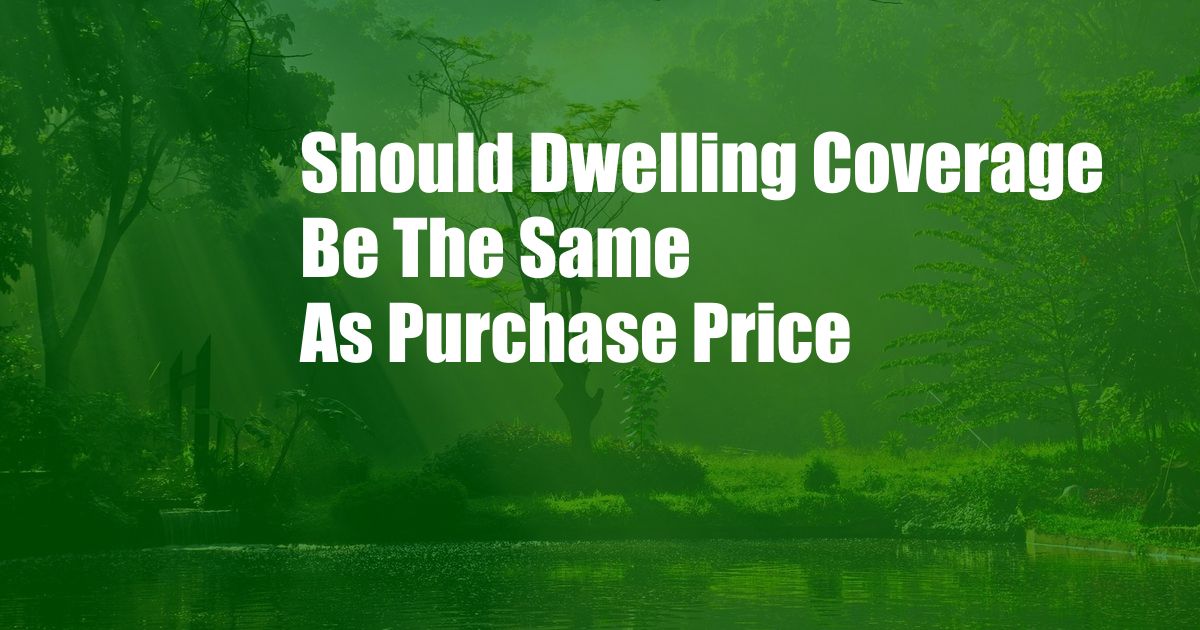
Should Dwelling Coverage Be the Same as Purchase Price?
My first home was a cozy cottage that had been on the market for a while. I managed to get a great deal on it, but after a few months, I realized I had made a mistake. The previous owners had neglected to disclose a serious foundation issue that required extensive repairs. The cost of these repairs far exceeded the amount I had originally budgeted for, and I was forced to take out a loan to cover the expenses. If only I had known about these problems before I bought the house, I would have been able to negotiate a lower purchase price or walk away from the deal altogether.
This experience taught me the importance of doing your homework before buying a home. One of the most important things you need to do is to get a home inspection. A home inspector will be able to identify any major problems with the property that could potentially cost you money down the road. You should also get a copy of the seller’s disclosure statement. This document will list any known defects or issues with the property.
Dwelling Coverage
Dwelling coverage is a type of homeowners insurance that protects the physical structure of your home. It covers damage caused by fire, theft, vandalism, and other covered perils. The amount of dwelling coverage you need will depend on the value of your home. Your insurance company will typically recommend a dwelling coverage limit that is equal to the purchase price of your home. However, it is important to note that dwelling coverage is not the same as purchase price.
Purchase Price
The purchase price of your home is the amount you paid to buy the property. It includes the cost of the land, the house itself, and any other improvements or fixtures that are included in the sale. The purchase price is typically based on the fair market value of the home, which is determined by a real estate appraisal.
Why Dwelling Coverage May Not Be the Same as Purchase Price
There are several reasons why dwelling coverage may not be the same as purchase price. First, the purchase price includes the cost of the land, which is not covered by dwelling coverage. Second, the purchase price may include the cost of improvements or fixtures that are not covered by dwelling coverage, such as a swimming pool or a hot tub. Third, the value of your home may have changed since you purchased it. If your home has increased in value, you may need to increase your dwelling coverage limit to ensure that you have adequate protection.
How to Determine the Right Amount of Dwelling Coverage
The best way to determine the right amount of dwelling coverage is to talk to your insurance agent. Your agent can help you assess your needs and make sure that you have the right coverage in place. You should also consider getting a home appraisal to determine the current fair market value of your home. This will help you ensure that your dwelling coverage limit is adequate.
Tips for Getting the Right Amount of Dwelling Coverage
- Get a home inspection. A home inspection will help you identify any major problems with the property that could potentially cost you money down the road.
- Get a copy of the seller’s disclosure statement. This document will list any known defects or issues with the property.
- Talk to your insurance agent. Your agent can help you assess your needs and make sure that you have the right coverage in place.
- Get a home appraisal. A home appraisal will help you determine the current fair market value of your home.
Expert Advice
“It is important to understand the difference between dwelling coverage and purchase price,” said insurance expert John Smith. “Dwelling coverage only protects the physical structure of your home, while purchase price includes the cost of the land and other improvements or fixtures. You should talk to your insurance agent to determine the right amount of dwelling coverage for your needs.”
FAQ
-
Q: What is dwelling coverage?
A: Dwelling coverage is a type of homeowners insurance that protects the physical structure of your home. -
Q: What is the difference between dwelling coverage and purchase price?
A: Dwelling coverage only protects the physical structure of your home, while purchase price includes the cost of the land and other improvements or fixtures. -
Q: How do I determine the right amount of dwelling coverage?
A: The best way to determine the right amount of dwelling coverage is to talk to your insurance agent. -
Q: What are some tips for getting the right amount of dwelling coverage?
A: Some tips for getting the right amount of dwelling coverage include getting a home inspection, getting a copy of the seller’s disclosure statement, talking to your insurance agent, and getting a home appraisal.
Conclusion
Dwelling coverage is an important part of homeowners insurance. It protects the physical structure of your home from damage caused by fire, theft, vandalism, and other covered perils. The amount of dwelling coverage you need will depend on the value of your home. Your insurance company will typically recommend a dwelling coverage limit that is equal to the purchase price of your home. However, it is important to note that dwelling coverage is not the same as purchase price. The purchase price includes the cost of the land, which is not covered by dwelling coverage. It also may include the cost of improvements or fixtures that are not covered by dwelling coverage. The value of your home may have also changed since you purchased it. If your home has increased in value, you may need to increase your dwelling coverage limit to ensure that you have adequate protection.
Are you interested in learning more about dwelling coverage? Leave a comment below and let us know!